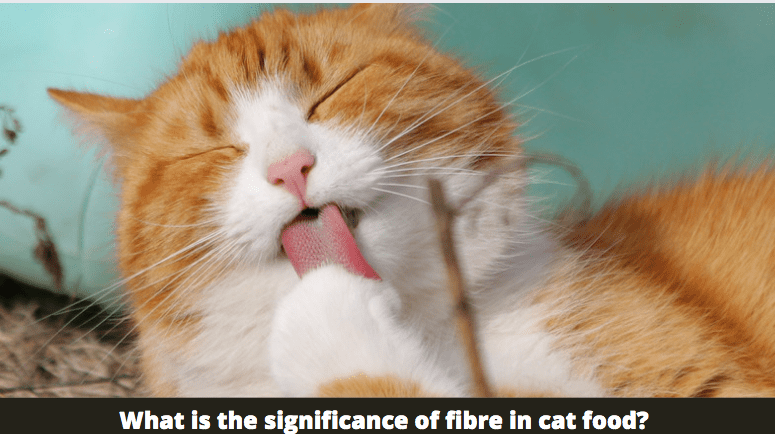What is the significance of fibre in cat food?
High-fibre cat food has become a mainstay in the diets of cats who suffer from digestive problems. But why is fibre so crucial for your furball of a cat in the first place?
There are numerous instances where fibre is included in cat food to aid in digestion and improve the stool quality of cats who could otherwise suffer from digestive discomfort.
Diets high in fibre may be effective in the treatment of constipation as well as diarrhea, diabetes and obesity.
A Study of the Microbiome and Its Interaction with Cat Food Contains Fiber
Gut microbiome is the term used to describe the many millions of microorganisms (bacteria, protozoa, fungus, viruses) that dwell inside the digestive systems of cats (and other living things), including dogs, humans, and other animals. The digesting process is dependent on this ecosystem of living organisms.
Bacteria in the colon of dogs aid in the digestion of indigestible material and the production of useful substances such as vitamins and minerals.
When it comes to breaking down fibres, there is no better example of the former function than in this case. Fermentation is a term used to describe the interaction of bacteria with fibres.
Cats, despite the fact that they are carnivores, can get tremendous benefits from consuming a cat chow that contains fibre.
Fibre in Cat Food Is Divided Into Types
Dietary fibre can be classified according to its solubility in water. Fibres that are easily soluble tend to dissolve in gastric juices and water in the gut, and some soluble fibres form gels that can contain water and make faeces easier to pass. Because they add volume to the food eaten, insoluble fibres can aid to control the transit of foodstuffs through the intestines, as well as improve the consistency of the faeces.
Fermentable fibres can be found in both soluble and insoluble forms. Because of the breakdown of these fibres by bacteria in the gut, the colon can develop new substances that can be used to nourish the cells of the colon.
Including Prebiotics in Cat Food That Also Has Fiber
Cat food containing fibre will often have a combination of soluble and insoluble fibre to aid in the promotion of a healthy gut and good stool quality.
Fibre elements that stimulate the growth of the “good bacteria” that live in the intestines are referred to as prebiotics. Prebiotics are substances, which are typically fermentable fibres, that help the body digest food.
Some high-fibre cat feeds are effective because they aid in the feeding of good bacteria and the promotion of a healthy microbiome in cats.
A variety of digestive problems, such as chronic diarrhea, colitis, and constipation, can result in a bacterial imbalance in the gut.
There are a variety of other reasons to provide high-fibre cat food.
Diabetic cats are normally fed high-protein, low-carbohydrate meals, but they may also benefit from high-fibre cat food if they are prone to getting overweight or if they have certain types of gastrointestinal disorders (GI diseases).
Some fibres inhibit the absorption of nutrients, allowing the sugars from carbohydrates to be taken more slowly and, as a result, allowing blood sugar levels to remain more stable over time.
Overweight cats or cats who are prone to weight gain may also benefit from high-fibre food since it may help them feel more satisfied than they would otherwise be — and weight loss may aid in the management of diabetes.
Furthermore, high-fibre cat food may be beneficial for cats suffering from gastrointestinal illnesses that damage the large intestine.
Fibre can assist in regulating the motility of the gastrointestinal tract as well as managing water balance in order to avoid the two extremes of constipation and diarrhea. Long-chain fatty acids, which are formed from the breakdown of fibre, may be able to replenish the colon via nourishing the intestinal lining.
Is High-Fiber Cat Food a Healthy Option?
When left to their own ways, cats eat a variety of foods that people consider indigestible, such as hair, bone, gristle, feathers, fish scales, and the stomach contents of their prey, among other things.
It’s disgusting, but it’s natural. Some of these are digestible to a certain extent, whilst others may contain fibre that is beneficial to digestion in some cases.
While there is still much to learn about feline nutrition, experts are beginning to discover that carnivorous cats, in particular, can benefit from fibre consumption.
An investigation into the cheetahs’ feeding habits, published in the Journal of Animal Science, discovered that those that ate full prey — including the fur as well as the stomach contents — had a more favourable faecal profile than those who ate only raw meat.
Researchers have come to the conclusion that carnivore digestive systems must be doing something valuable with all of the extra roughage as a result of this.
The Importance of High-Fibre Cat Food
What if your veterinarian advises you to feed your cat low-fibre cat food instead?
Typically, veterinarians recommend a low-fibre diet for cats that have experienced a quick start of GI discomforts, such as vomiting or diarrhea, according to their clinical judgment. This type of food typically has higher quantities of other nutrients, like electrolytes and B-vitamins, which can aid in the healing of these cats.
When choosing a meal for your cat, always consult with a veterinarian first. If your cat is on a high-fibre diet, their veterinarian should keep an eye on them to ensure that any fibre-responsive conditions are being properly controlled.
Fact-Finding:
Thanks for reading and have a great day! What is the significance of fibre in cat food?
Please post your thoughts in the comments section if you have any. Please feel free to share!

